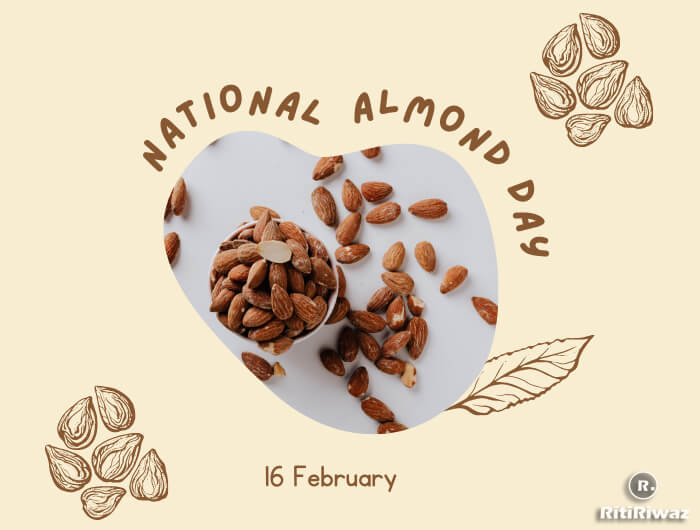National Almond Day

National Almond Day is all about celebrating the goodness of the nuts Almond on February 16. Almond is believed to be one of the most ancient fruits to be cultivated. Did you know that almonds are one of the most heart-healthy foods on the market? Good for your heart. Good for your waistline. Good for your skin. What can’t almonds do? So on February 16, National Almond Day, let’s pay tribute to these tiny powerhouses packed with goodness!
Almonds are an excellent source of vitamin E and magnesium, they have the highest level of protein and fiber among all tree nuts. They may help promote healthy blood pressure and cholesterol levels. They may also help with weight loss by keeping you feeling full longer. The protein in almonds is more like a protein of human breast milk, which is why almonds are the best base for baby formulas. One ounce of almonds has just 161 calories but a whopping 3.5 grams of fiber, 6 grams of protein, 9 grams of healthy fats, 2.5 grams of carbs, and half of the recommended daily amount of Vitamin E all wrapped up into just 23 nuts.
History of Almond
The ancient nut is mentioned several times in both the New and Old Testaments as a symbol of divine approval. Almonds are mentioned as far back in history as the Bible! Although their first place of origin is debated, almonds were thought to have first been cultivated in China and Central Asia.
The Almond Board of California points out that almonds are mentioned in the Old Testament. In the book of Numbers, almonds grow out of a staff carried by Aaron. The day marks the beginning of the time of year when the trees began to bloom in California – the only state that produces almonds commercially.
Almonds were used as a wedding gift in ancient Rome. Almond trees flourished in Spain, Greece, Israel, and Morocco, the board’s history web page says, and found their way from Spain to California with Franciscan priests.
Even though almonds have been eaten and enjoyed in so many places in the world, throughout history, the state of California produces a surprisingly 80 percent of the world’s supply.
Different Types of Almonds
There are a few different types of almonds from almond trees distinct to various regions of the world, each with its characteristics. For example, nonpareil almonds, which are archetypal of California, are firmer, larger, and have a thinner shell and skin than Marcona almonds, which grow in Spain. Most of the almonds enjoyed in the world (about 80%) come from California orchards. Different types of almonds are best for different uses, such as nonpareils such as “snacking almonds.”
Any kind of almond is bound to add a nice crunch to a cooked dish or act as a filling foundation for an afternoon snack. Try a couple of different types of almonds in a homemade trail mix alongside dried fruit and seeds, or roast and eat them on their own to fully recognize the individual flavors. The nut is quite popular for its superb snacking potential in sweet or savory modes. It’s also easy to incorporate into meals and baked goods.
How to Observe National Almond Day
To celebrate National Almond Day on February 16, try something new when cooking with almonds. You can consume almonds in so many forms: whole — raw or roasted — blanched, chopped, sliced, and slivered. Almonds are turned into flour, paste, butter, oil, milk, and meal.
Almond oil and almond milk can help your skin and hair, even! And of course, almonds are so yummy. Almond is even one of my favorite smells in things like liquid soaps, shampoos, and candles! So use this day to celebrate Almond.
Almonds are one of the most versatile nuts to have and they make a great food to eat for a healthier life. And they do contain nutrients your body needs. So even if the specific benefits aren’t clear, they are a good addition to your diet.
Happy National Almond Day
Suggested Read: National Nut Day






